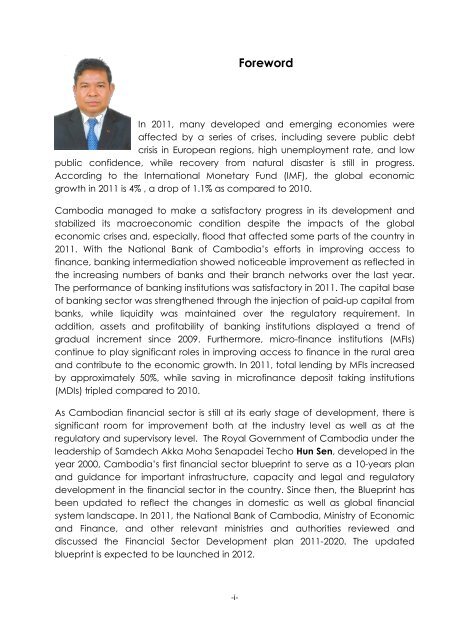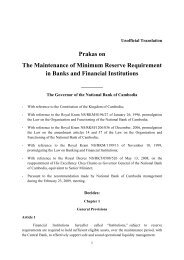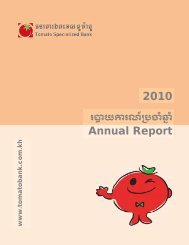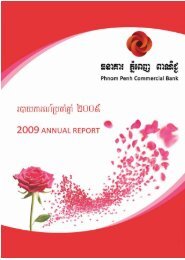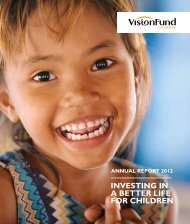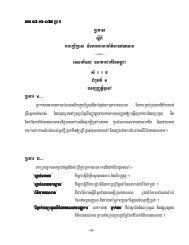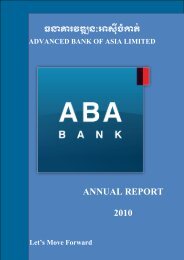National Bank of Cambodia
National Bank of Cambodia
National Bank of Cambodia
- No tags were found...
You also want an ePaper? Increase the reach of your titles
YUMPU automatically turns print PDFs into web optimized ePapers that Google loves.
ForewordIn 2011, many developed and emerging economies wereaffected by a series <strong>of</strong> crises, including severe public debtcrisis in European regions, high unemployment rate, and lowpublic confidence, while recovery from natural disaster is still in progress.According to the International Monetary Fund (IMF), the global economicgrowth in 2011 is 4% , a drop <strong>of</strong> 1.1% as compared to 2010.<strong>Cambodia</strong> managed to make a satisfactory progress in its development andstabilized its macroeconomic condition despite the impacts <strong>of</strong> the globaleconomic crises and, especially, flood that affected some parts <strong>of</strong> the country in2011. With the <strong>National</strong> <strong>Bank</strong> <strong>of</strong> <strong>Cambodia</strong>’s efforts in improving access t<strong>of</strong>inance, banking intermediation showed noticeable improvement as reflected inthe increasing numbers <strong>of</strong> banks and their branch networks over the last year.The performance <strong>of</strong> banking institutions was satisfactory in 2011. The capital base<strong>of</strong> banking sector was strengthened through the injection <strong>of</strong> paid-up capital frombanks, while liquidity was maintained over the regulatory requirement. Inaddition, assets and pr<strong>of</strong>itability <strong>of</strong> banking institutions displayed a trend <strong>of</strong>gradual increment since 2009. Furthermore, micro-finance institutions (MFIs)continue to play significant roles in improving access to finance in the rural areaand contribute to the economic growth. In 2011, total lending by MFIs increasedby approximately 50%, while saving in micr<strong>of</strong>inance deposit taking institutions(MDIs) tripled compared to 2010.As <strong>Cambodia</strong>n financial sector is still at its early stage <strong>of</strong> development, there issignificant room for improvement both at the industry level as well as at theregulatory and supervisory level. The Royal Government <strong>of</strong> <strong>Cambodia</strong> under theleadership <strong>of</strong> Samdech Akka Moha Senapadei Techo Hun Sen, developed in theyear 2000, <strong>Cambodia</strong>’s first financial sector blueprint to serve as a 10-years planand guidance for important infrastructure, capacity and legal and regulatorydevelopment in the financial sector in the country. Since then, the Blueprint hasbeen updated to reflect the changes in domestic as well as global financialsystem landscape. In 2011, the <strong>National</strong> <strong>Bank</strong> <strong>of</strong> <strong>Cambodia</strong>, Ministry <strong>of</strong> Economicand Finance, and other relevant ministries and authorities reviewed anddiscussed the Financial Sector Development plan 2011-2020. The updatedblueprint is expected to be launched in 2012.-i-


